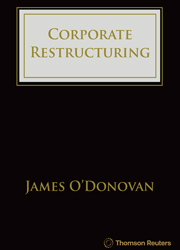
Corporate Restructuring
|
Book $238.01* $280.01 RRP Save: $42.00 (15%) |
Date: 28/07/2025 Code: 9780455503134 Thomson Reuters, AUSTRALIA |

Corporate Restructuring
Sale Price: $238.01
Saving: $42.00 |
Browse:
Available Formats
| Format | Title | Date | Code | Price | |
|---|---|---|---|---|---|
| Book | Corporate Restructuring | 28/07/2025 | 9780455503134 | $238.01 |
Add to cart

Corporate Restructuring
Sale Price: $238.01
Saving: $42.00 |
| eBook - ProView | Corporate Restructuring eBook | 31/07/2025 | 9780455503141 | $238.01 |
Add to cart

Corporate Restructuring eBook
Sale Price: $238.01
Saving: $42.00 |
| Book+eBook | Corporate Restructuring Book + eBook | 31/07/2025 | 43368388 | $308.55 |
Add to cart

Corporate Restructuring Book + eBook
Sale Price: $308.55
Saving: $54.45 |
Description
Corporate Restructuring is a concise but comprehensive analysis of the law and practice of restructuring in Australia. It is intended to serve secured and unsecured creditors, members, third parties, insolvency practitioners, and their legal advisors.
More than 11,000 companies entered external administration for the first time in 2023-24. The number of external administrations grew by 39% in 2023-24, and they are expected to rise by a further 25% in 2024/25. Indeed, the ATO has issued 27,000 Director Penalty Notices (DPNs) worth $4.4B in the past year. These DPNs are likely to trigger a further wave of corporate insolvencies.
Corporate restructuring may involve restructuring debts, shares, options, or other assets. It can involve solvent and insolvent companies and both members and creditors.
Corporate restructuring in Australia is regulated by three discrete regimes:
- Corps Act 2001, Part 5.1, dealing with schemes of arrangement;
- Part 5.3A, dealing with voluntary administration and deeds of company arrangement; and
- Part 5.3B, dealing with small business restructuring.
The procedures in each of these regimes are different and they have different effects on secured and unsecured creditors, members, employees, and third parties. The powers, duties and liabilities of the external administrators who undertake these forms of administration are regulated by an elaborate web of legislation, case law, and professional standards.
While voluntary administration and small business restructuring focuses on insolvent companies, schemes of arrangement can be used by both solvent and insolvent companies. Members’ schemes of arrangement raise issues relating to variations of class rights, the prohibition on financial assistance to companies in purchasing their own shares, share buy-backs, reductions of capital, and protection of employee entitlements. All these topics are clearly and concisely analysed in this treatise.
Additional features include:
- Appendices on the GST liabilities of external administrators,
- Taxation Implications of Corporate Restructuring and The Second Tranche of AML/CTF reforms affecting external administrators.
There is also a set of forms and precedents.
You Might Also Like
-

Keay's Insolvency: Personal & Corporate Law and Practice, ...Book
$200.00 $80.00
-

Keay's Insolvency: Personal & Corporate Law and Practice, ...Book+eBook
$259.00 $103.60
-

Keay's Insolvency: Personal & Corporate Law and Practice, ...eBook - ProView
$200.00 $80.00
 Bankruptcy & Insolvency
Bankruptcy & Insolvency